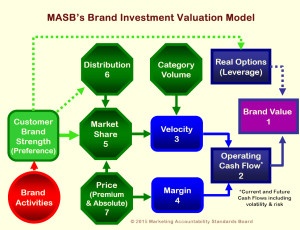MASB Summer Summit 2015
An empirically proven model for brand valuation and guiding investment decisions has been completed by MASB’s Brand Investment Valuation Project.
“It definitely has been a long haul,” commented Frank Findley, Vice President of R&D for MSW•ARS Research, as he presented the model at MASB’s Summer Summit.

Representatives from General Motors, ConAgra, MillerCoors, PepsiCo, Kimberly-Clark, The Hershey Company, The Nielsen Company and several universities were members of the BIV Project.
The project had three components. The Finance Sub-Team focused on modeling. The Analytics Sub-Team tracked a customer brand strength metric for 18 months across a series of categories – all the brands in those categories. The Integration Sub-Team used that data to prove out the conceptual model.
“Through this process, we actually refined that model and made some significant changes,” Findley related as he explained the project.
The Brand Valuation Model – Conceptual Links
 Brand activities lead to Customer Brand Strength/Preference, the place the brand holds in the hearts and minds of consumers. The ability of brand preference to isolate brand strength from other market factors separates it from other marketing measures.
Brand activities lead to Customer Brand Strength/Preference, the place the brand holds in the hearts and minds of consumers. The ability of brand preference to isolate brand strength from other market factors separates it from other marketing measures.
Brand Strength drives Market Share and also has interaction with Distribution and Price. Distribution is affected when companies use Preference to decide what products to have on the shelves. Price is a factor both in terms of premium versus the competition (high price could drive consumers to a different brand) and in terms of market (how much return from each unit sold).
Market Share goes to Velocity (the flow of money into the business) and that’s paired with Margin to determine Operating Cash Flow (the amount the brand actually returns to the organization). Using a net present value calculation on current and future cash flows, considering volatility and risk, results in Brand Value.
There are other ways in which Cash Flow can enhance the value of a brand. If the brand were to stop, there is a terminal value associated with it. There are also opportunities for leveraging Brand Strength across segments or categories. Real Options are those types of strategic considerations where a brand could move from a shampoo to a conditioner to a hair styling product and could extend into other segments. Even though it currently doesn’t have that cash flow, there is a value associated with that.
The model indicates a direct trade-off between price premium and preference. Low price results in higher share than brand preference, high price lessens share. Distribution plays a role, but to a lesser degree.
